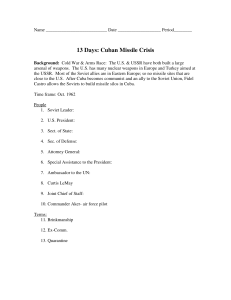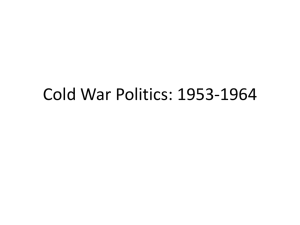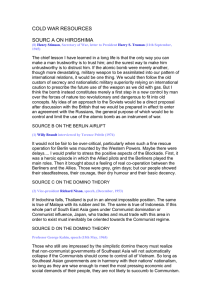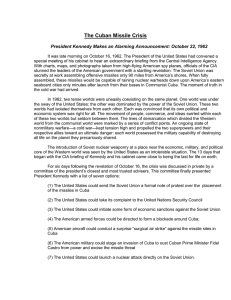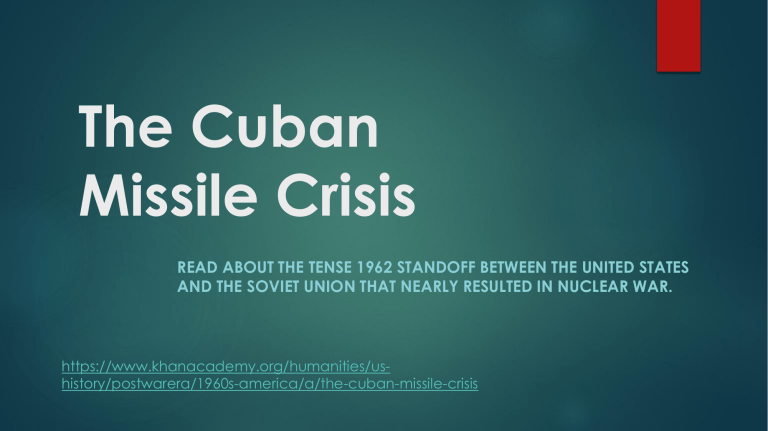
The Cuban Missile Crisis READ ABOUT THE TENSE 1962 STANDOFF BETWEEN THE UNITED STATES AND THE SOVIET UNION THAT NEARLY RESULTED IN NUCLEAR WAR. https://www.khanacademy.org/humanities/ushistory/postwarera/1960s-america/a/the-cuban-missile-crisis Overview In October 1962, the Soviet provision of ballistic missiles to Cuba led to the most dangerous Cold War confrontation between the United States and the Soviet Union and brought the world to the brink of nuclear war. Over the course of two extremely tense weeks, US President John F. Kennedy and Soviet Premier Nikita Khrushchev negotiated a peaceful outcome to the crisis. The crisis evoked fears of nuclear destruction, revealed the dangers of brinksmanship, and invigorated attempts to halt the arms race. The Cuban Revolution After waging a successful guerrilla war against the regime of Cuban dictator Fulgencio Batista, Fidel Castro came to power on January 1, 1959. Castro was not yet a communist, and US policymakers initially took a cautious wait-and-see approach to his regime. Over the course of 1959 and 1960, US-Cuban relations worsened due to Castro’s anti-US rhetoric and radical policies, especially his refusal to hold elections. When it became clear that Castro intended to pursue an alliance with the Soviet Union, President Dwight Eisenhower cut off diplomatic ties to Cuba and began preparing contingency plans for overthrowing Castro and replacing him with someone more amenable to the United States. Cuban Prime Minister Fidel Castro, left, shakes hands with Soviet Premier Nikita Khrushchev in 1961. Image courtesy Wikimedia Commons. As US-Cuban relations deteriorated, Castro turned to the Soviet Union for support. The Soviets signed multiple trade and aid agreements with Cuba, provided Castro with arms and weaponry, and also gave political support to the Cuban Revolution in the United Nations and other international organizations. Origins of the Cuban Missile Crisis The origins of the Cuban Missile Crisis lie in the failed Bay of Pigs invasion, https://www.history.com/topics/cold-war/bay-of-pigs-invasion during which US-supported Cuban exiles hoping to foment an uprising against Castro were overpowered by the Cuban armed forces. After the invasion, Castro turned to the Soviets for protection against future US aggression. The Soviets provided Cuba with nuclear weapons on the condition that the deal would remain secret until the missiles were fully operational.^11start superscript, 1, end superscript Khrushchev claimed that his motivation for providing Cuba with nuclear weaponry was to safeguard the Cuban Revolution against US aggression and to alter the global balance of power in favor of the Soviet Union US U-2 Spy planes In October 1962, US U-2 spy plane flights over Cuban territory revealed the missile installation sites. This discovery inaugurated what became known as the Cuban Missile Crisis. The strategic implications of these weapons were enormous: the missiles could easily reach targets in the United States, including New York City and Washington, D.C. Spies found the nukes first… Then they sent in the planes…. https://www.smithsonianmag.com/smartnews/how-cia-backed-spies-detectedrussian-nukes-first-during-cuban-missilecrisis-180971341/ You get to be president for a day. What would you have done? https://edsitement.neh.gov/student-activities/cuban-missile-crisisinteractive So what did he do? The Kennedy administration established a naval blockade to prevent any more missiles from reaching Cuba, and in no uncertain terms demanded the immediate removal of the missiles that had already been delivered. The danger of this approach was that if the Soviets refused to remove the missiles, the United States would be forced to escalate the crisis by authorizing air strikes over Cuba to bomb the missile sites. Contingency plans were drawn up for a fullscale invasion of Cuba and a nuclear attack on the Soviet Union, in the event that the Soviets responded militarily to Kennedy’s demands.^33 Negotiating a peaceful outcome Though Khrushchev initially refused to acknowledge the presence of the missiles in Cuba and declared the US naval blockade to be an act of war, he ordered the suspension of all weapons deliveries currently in transit. Over the course of approximately two weeks, Kennedy and Khrushchev negotiated a peaceful outcome to the missile crisis. The Soviets compared their provision of nuclear weapons to Cuba with the stationing of Jupiter missiles in Turkey, which were in range of Soviet territory. Kennedy agreed to remove the missiles from Turkey, and also pledged that the US government would not undertake another invasion of Cuba. Negotiating a peaceful outcome Throughout the negotiations, Khrushchev failed to consult with Castro. For Castro, this was humiliating and seemed to prove that the Soviets prioritized relations with the United States over relations with their own allies. Castro hoped to negotiate the closing of the US naval base at Guantanamo and the cessation of U-2 flights over Cuban territory. Ultimately, Khrushchev agreed to remove all of the nuclear missiles from Cuba, while failing to even broach the subject of Castro’s demands.^44 Consequences of the Cuban Missile Crisis Although the Soviets attempted to portray the outcome of the missile crisis as a victory, one of the consequences of the crisis was the ouster of Khrushchev. He was forced into retirement by other Soviet officials who claimed that the missile crisis was proof of Khrushchev’s reckless decisionmaking and his inability to lead the Soviet Union. Khrushchev’s successor, Leonid Brezhnev, came to power and sought to reduce tensions with the United States. Consequences of the Cuban Missile Crisis John F. Kennedy came out of the crisis in a much better position. His calm but firm stance in the negotiations was heralded as great statesmanship, though it is often forgotten that his bungling of the Bay of Pigs invasion had helped lead to the missile crisis in the first place. The Cuban Missile Crisis also convinced Kennedy of the dangers of nuclear brinksmanship. He and Khrushchev had peered into the abyss of nuclear destruction but had managed to pull back from it. In order to prevent future crises, a Moscow-Washington hotline was set up in the White House to facilitate direct communication between the leaders of the Soviet Union and the United States. Consequences of the Cuban Missile Crisis In August 1963, the United States, the Soviet Union, and Great Britain signed a treaty banning atmospheric and underwater nuclear testing. Nevertheless, the test-ban treaty failed to halt the arms race, as Kennedy simultaneously authorized a massive arms buildup that vastly expanded the US nuclear arsenal and amplified US strategic superiority in the Cold War.^55 What do you think? Why did Khrushchev decide to provide Cuba with nuclear missiles? Were there winners and losers in the Cuban Missile Crisis? If so, who were they? What were the positive and negative consequences of the missile crisis? Other resources Cuban Missile Crisis - The Failed Checkmate - Extra History - #1 https://www.youtube.com/watch?v=xqJBibhR07w Cuban Missile Crisis - Eyeball to Eyeball - Extra History - #2 https://www.youtube.com/watch?v=QQT4Dt82Kz0
